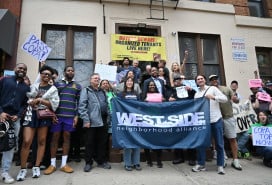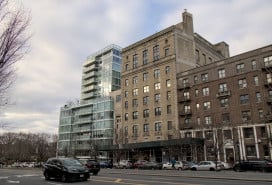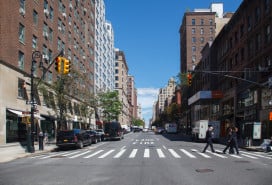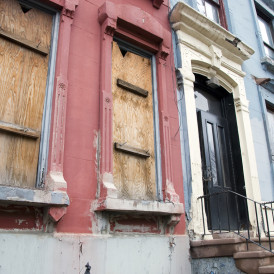Thinking about the homeless in a NYC heatwave: An essay
- How can I rest easy in my comfortably cool apartment when there are people sleeping on the pavement?
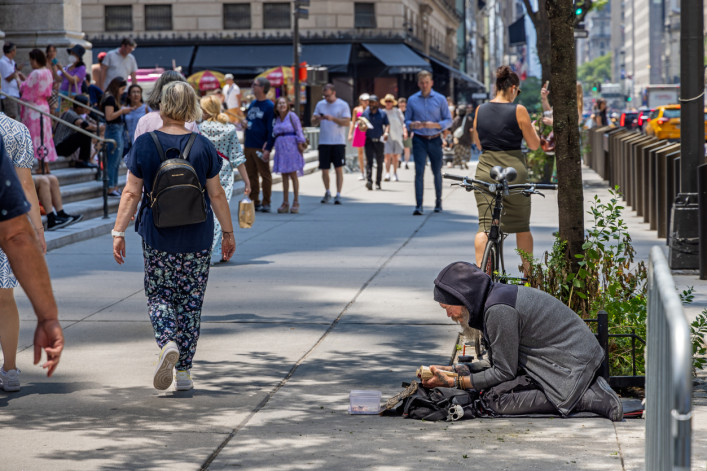
The primary cause of homelessness is very straightforward: the lack of affordable housing.
iStock
When New York City summer temperatures hit the mid 90s and humidity comes on full force, it is miserable—even life-threatening—to be on the street for an extended period of time.
I couldn’t help but wonder why a homeless person would remain outdoors instead of heading to a shelter. I felt compelled to ask a woman who was camped out on a Brooklyn sidewalk that question since there’s a women-only shelter just a few blocks away. She had her possessions arrayed around her in the meager shade of a shuttered newsstand outside CTown and was open to talking.
She told me she left the shelter because she didn’t feel safe: there were too many fights and she was bullied. And so she ended up on 9th Street in Park Slope. This was right before the heatwave started, but it was still very hot out.
The woman told me she just had to hang on just a few more days because she was on a list for an apartment. I have no way of knowing if that was true or not. I gave her some money, and while we were talking, another passerby gave her food and water and she blessed us both repeatedly. When I went back a day later, she was gone.
With NYC's increasingly extreme summers and winters, the question seems obvious: how can I rest easy in my comfortable apartment when there are people sleeping on the pavement?
A heatwave means Code Red
NYC has an extensive protocol that goes into place during a heatwave, called Code Red. There’s a similar plan that goes into effect during freezing temperatures—Code Blue.
A Department of Social Services spokesperson told me that during extreme weather conditions, outreach teams redouble their canvassing efforts across all five boroughs. The goal is to engage New Yorkers experiencing unsheltered homelessness and encourage them to come inside off the streets and connect with city resources. Those include cooling and drop-in centers.
“As part of our Code Red efforts during this heat wave, DHS and our provider-partner outreach teams are equipped with necessary supplies and continue to be out there around the clock, conducting enhanced efforts throughout and ensuring we are prioritizing the health and safety of some of our most vulnerable New Yorkers,” the spokesperson said.
Highest level of homelessness
According to the Coalition for the Homeless, homelessness in NYC has reached the highest level since the Great Depression. In April 2024, 132,057 people slept each night in NYC shelters. The organization says thousands sleep unsheltered in public spaces—an exact number is impossible to determine.
However, the record increase in the shelter census is primarily driven by the more than 200,000 asylum seekers who have come through NYC’s intake system since spring 2022, according to DSS. Recent arrivals are not typically eligible for rental subsidies so the city is providing emergency transitional housing. If you factor out the asylum population, the number of New Yorkers seeking shelter is 7 percent below the pre-pandemic peak.
The primary cause of homelessness is very straightforward: the lack of affordable housing. An analysis by McKinsey & Company for the Regional Plan Association identified a shortage of 540,000 housing units for the tri-state region. City of Yes, a housing development plan from Mayor Eric Adams, calls for building more housing in every NYC neighborhood, but it is likely to face fierce opposition.
I see this duality in my reporting and in my conversations with friends and neighbors: New Yorkers understand there is a housing crisis—they experience the high cost of housing themselves. But the majority do not want more affordable housing—which needs density to make it financially feasible, developers say—built on their block because that would require zoning changes to allow for bigger buildings. Few seem to be in favor because of the impact it will have on the character of their neighborhood, or because more housing will make parking more difficult or take up seats in their neighborhood's schools—these are the concerns.
And plans to create housing shelters draw even more vociferous opposition.
Right in your face
Homelessness is not an abstract problem. It’s always right in your face, maybe that’s why it isn’t really seen until someone who is homeless gets uncomfortably close, like on your block or in your own building. Brick received several queries recently from readers wanting to know what they could do about homeless people entering where they lived.
In one case, a homeless person was repeatedly entering a building via a front door that is not kept locked. In another case, we heard about someone paying a landlord to sleep in a hallway. Tenants were choosing to look the other way for now.
“We know the situation is illegal, but we worry reporting it will do more harm than good,” they wrote.
Some situations are more complicated, for example, during the heatwave, a post on NextDoor asked for ways to help someone sleeping at the edge of Prospect Park and refusing assistance. Part of the problem was that the homeless person had a lot of stuff: it was piled all around a park bench, even hanging in a nearby tree, and creating a mess, according to the post. Many comments argued for this person’s right to be left alone. Eventually, the Parks Department intervened, it seems.
It's hard to help someone who doesn’t want help and may be suffering from mental illness but I can’t imagine force is effective in the long run, which is why the U.S. Supreme Court’s recent decision is chilling.
Last Friday’s ruling upheld an Oregon city’s ban on homeless people sleeping outdoors. The ordinances penalize sleeping and camping in public places like sidewalks, streets, and city parks.
So many shelters, so many protests
Weirdly enough, on the same day a friend invited me to join a community group opposed to a 300-bed homeless shelter proposed for Greenwood Heights, a City Councilmember was arrested during a protest against the city’s plan to put a 150-bed shelter in Bensonhurst.
City Councilmember Susan Zhuang was charged on Wednesday with assault and accused of biting a police officer. According to The City, there have been weeks of demonstrations from the neighborhood’s Asian American community. The district doesn’t currently have a single homeless shelter, the site said.
Interestingly, this friend and I both once lived across the street from the women’s shelter in Park Slope. Sometimes it was noisy and sometimes there were emergency vehicles parked outside, but it wasn’t very different from any of the other places I’ve lived in NYC.
‘Have compassion’
I asked Ellen Davidson, a staff attorney at the Legal Aid Society, what New Yorkers could do about homeless people, including when they enter your building.
“For anyone wondering what they can do about a homeless person sleeping on your block or your building, I would advise them to have compassion for someone who is trying to escape unbearable conditions outside,” Davidson said.
Regarding the homeless person sleeping in a hallway, Davidson said, “The landlord giving a person space to sleep is a moral thing to do.”
Then Davidson turned my questions around: Where have these tenants been when our elected officials slashed resources for homeless people? she asked.
“When a community opposes having shelters and changing zoning to create density and build more affordable and supportive housing, there are consequences,” she said. “People have nowhere to go.
“To the extent that it bothers you to see homeless people sleeping on the street or next to your building, make it priority to elect people who will build supportive and affordable housing,” she added.
If you see an individual who appears to be experiencing homelessness/in need outdoors in extreme heat/weather conditions, the Department of Social Services advises you to call 311 and an outreach team will be dispatched to help. For information about signs of heat illness, or where to find a cooling center in NYC, go here.


